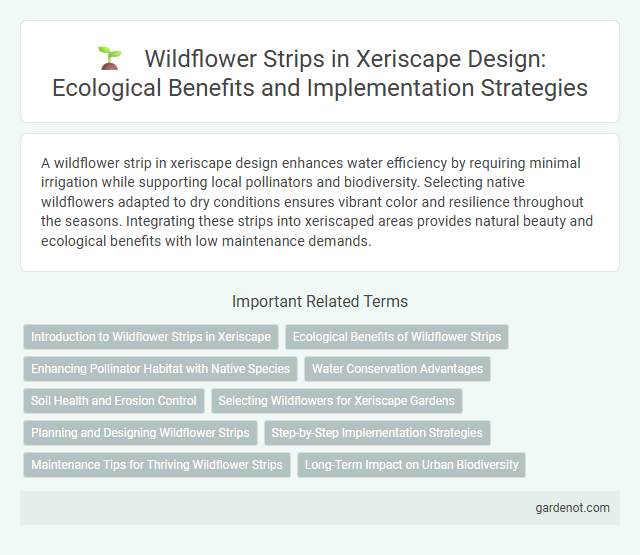A wildflower strip in xeriscape design enhances water efficiency by requiring minimal irrigation while supporting local pollinators and biodiversity. Selecting native wildflowers adapted to dry conditions ensures vibrant color and resilience throughout the seasons. Integrating these strips into xeriscaped areas provides natural beauty and ecological benefits with low maintenance demands.
Introduction to Wildflower Strips in Xeriscape
Wildflower strips in xeriscape landscaping create vibrant, drought-tolerant habitats that conserve water and support local biodiversity. By using native wildflowers like Gaillardia, Echinacea, and Black-eyed Susan, these strips enhance soil health and attract pollinators such as bees and butterflies. Incorporating wildflower strips reduces irrigation needs while promoting sustainable garden aesthetics in arid climates.
Ecological Benefits of Wildflower Strips
Wildflower strips support biodiversity by providing essential habitats and food sources for pollinators like bees, butterflies, and birds. These strips improve soil health through natural nutrient cycling and reduce erosion by stabilizing the ground with deep-rooted native plants. Integrating wildflower strips in xeriscaping enhances ecosystem resilience while lowering water usage and chemical inputs.
Enhancing Pollinator Habitat with Native Species
A wildflower strip planted with native species significantly improves pollinator habitat by providing diverse nectar and pollen sources throughout the growing season. Incorporating regional wildflowers such as purple coneflower, black-eyed Susan, and bee balm supports native bees, butterflies, and hummingbirds, promoting local biodiversity. These strips also increase resilience to drought and reduce maintenance requirements, aligning with xeriscape principles.
Water Conservation Advantages
Wildflower strips in xeriscape landscaping significantly reduce water consumption by utilizing drought-tolerant native species that thrive with minimal irrigation. These plants improve soil moisture retention through deep root systems, decreasing the need for supplemental watering. Implementing wildflower strips enhances ecosystem resilience while conserving valuable water resources in arid and semi-arid regions.
Soil Health and Erosion Control
Wildflower strips enhance soil health by increasing organic matter and promoting beneficial microbial activity, which improves nutrient cycling and water retention. Their deep-rooted native plants stabilize soil, reducing erosion by anchoring topsoil and minimizing surface runoff. Incorporating diverse wildflower species creates a resilient ecosystem that supports long-term soil structure and fertility in xeriscape landscapes.
Selecting Wildflowers for Xeriscape Gardens
Selecting wildflowers for xeriscape gardens involves choosing drought-tolerant species native to arid regions, such as California poppies, blanket flowers, and purple coneflowers. These wildflowers thrive with minimal water and enhance biodiversity by providing nectar sources for pollinators like bees and butterflies. Incorporating diverse wildflower strips improves soil health and reduces maintenance while creating vibrant, sustainable landscapes.
Planning and Designing Wildflower Strips
Planning and designing wildflower strips requires selecting native, drought-tolerant species that thrive in local climates and support pollinators like bees and butterflies. Proper site assessment, including soil quality and sunlight exposure, ensures optimal growth and sustainability. Incorporating diverse plant heights and bloom times enhances ecological benefits and visual appeal throughout the seasons.
Step-by-Step Implementation Strategies
Establish a wildflower strip by first selecting native, drought-tolerant species that thrive in local climate conditions to ensure minimal irrigation needs. Prepare the soil by removing invasive plants, tilling lightly, and applying a thin layer of compost to foster healthy seed germination. Sow seeds evenly during early spring or fall, followed by gentle watering and consistent monitoring to promote robust growth and sustainable xeriscape integration.
Maintenance Tips for Thriving Wildflower Strips
Regular watering during the initial establishment phase is crucial for thriving wildflower strips, ensuring deep soil moisture without over-saturation. Seasonal mulching helps retain soil moisture, suppress weeds, and promote healthy root growth in xeriscape environments. Periodic thinning and removal of invasive species support biodiversity and prevent overcrowding, enhancing the wildflowers' overall vigor and bloom longevity.
Long-Term Impact on Urban Biodiversity
Wildflower strips significantly enhance urban biodiversity by providing essential habitats and food sources for pollinators such as bees, butterflies, and native birds over extended periods. Their deep-rooted native plants improve soil health and water retention, promoting ecological balance in drought-prone urban landscapes. This sustainable vegetation supports resilient ecosystems, contributing to long-term urban environmental stability and biodiversity conservation.
Wildflower strip Infographic

 gardenot.com
gardenot.com